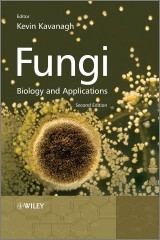Details

Fungi
Biology and Applications2. Aufl.
|
48,99 € |
|
| Verlag: | Wiley |
| Format: | |
| Veröffentl.: | 02.08.2011 |
| ISBN/EAN: | 9781119976967 |
| Sprache: | englisch |
| Anzahl Seiten: | 384 |
DRM-geschütztes eBook, Sie benötigen z.B. Adobe Digital Editions und eine Adobe ID zum Lesen.
Beschreibungen
<i>Fungi: Biology and Applications</i>, Second Edition provides a comprehensive treatment of fungi, covering biochemistry, genetics and the medical and economic significance of these organisms at introductory level. With no prior knowledge of the subject assumed, the opening chapters offer a broad overview of the basics of fungal biology, in particular the physiology and genetics of fungi and also a new chapter on the application of genomics to fungi. Later chapters move on to include more detailed coverage of topics such as antibiotic and chemical commodities from fungi, new chapters on biotechnological use of fungal enzymes and fungal proteomics, and fungal diseases of humans, antifungal agents for use in human therapy and fungal pathogens of plants.
<b>List of Contributors ix</b> <p><b>1 Introduction to Fungal Physiology 1</b><br /> <i>Graeme M. Walker and Nia A. White</i></p> <p>1.1 Introduction 1</p> <p>1.2 Morphology of Yeasts and Fungi 2</p> <p>1.3 Ultrastructure and Function of Fungal Cells 4</p> <p>1.4 Fungal Nutrition and Cellular Biosyntheses 11</p> <p>1.5 Fungal Metabolism 21</p> <p>1.6 Fungal Growth and Reproduction 26</p> <p>1.7 Conclusions 33</p> <p><b>2 Fungal Genetics 37</b><br /> <i>Malcolm Whiteway and Catherine Bachewich</i></p> <p>2.1 Introduction 37</p> <p>2.2 Fungal Life Cycles 39</p> <p>2.3 Sexual Analysis: Regulation of Mating 46</p> <p>2.4 Unique Characteristics of Filamentous Fungi that are Advantageous for Genetic Analysis 51</p> <p>2.5 Genetics as a Tool 52</p> <p>2.6 Conclusion 62</p> <p><b>3 Fungal Genomics 67</b><br /> <i>David Fitzpatrick and Edgar Mauricio Medina Tovar</i></p> <p>3.1 Introduction 67</p> <p>3.2 Genome Sequencing 73</p> <p>3.3 Bioinformatics Tools 77</p> <p>3.4 Comparative Genomics 83</p> <p>3.5 Genomics and the Fungal Tree of Life 87</p> <p>3.6 Online Fungal Genomic Resources 89</p> <p>3.7 Conclusion 92</p> <p><b>4 Fungal Genetics: A Post-Genomic Perspective 95</b><br /> <i>Brendan Curran and Virginia Bugeja</i></p> <p>4.1 Introduction 95</p> <p>4.2 Genomics 96</p> <p>4.3 Transcriptomics and Proteomics 106</p> <p>4.4 Proteomics 110</p> <p>4.5 Systems Biology 119</p> <p>4.6 Conclusion 121</p> <p><b>5 Fungal Fermentations Systems and Products 125</b><br /> <i>Kevin Kavanagh</i></p> <p>5.1 Introduction 125</p> <p>5.2 Fungal Fermentation Systems 126</p> <p>5.3 Commercial Fungal Products 132</p> <p>5.4 Conclusion 145</p> <p><b>6 Pharmaceutical and Chemical Commodities from Fungi 147</b><br /> <i>Karina A. Horgan and Richard A. Murphy</i></p> <p>6.1 Introduction to Pharmaceutical and Chemical Commodities 147</p> <p>6.2 Fungal Metabolism 148</p> <p>6.3 Antibiotic Production 150</p> <p>6.4 Pharmacologically Active Products 156</p> <p>6.5 Chemical Commodities 162</p> <p>6.6 Yeast Extracts 172</p> <p>6.7 Enriched Yeast 174</p> <p>6.8 Conclusions 177</p> <p><b>7 Biotechnological Use of Fungal Enzymes 179</b><br /> <i>Shauna M. McKelvey and Richard A. Murphy</i></p> <p>7.1 Introduction to Enzymes 179</p> <p>7.2 Enzymes in Industry 180</p> <p>7.3 Current Enzyme Applications 180</p> <p>7.4 Future Direction of Industrial Enzymes 186</p> <p>7.5 Specific Enzymes 186</p> <p>7.6 Enzyme Production Strategies 201</p> <p>7.7 Conclusions 202</p> <p><b>8 The Biotechnological Exploitation of Heterologous Protein Production in Fungi 205</b><br /> <i>Brendan Curran and Virginia Bugeja</i></p> <p>8.1 Introduction 205</p> <p>8.2 Heterologous Protein Expression in Fungi 206</p> <p>8.3 Case Study: Hepatitis B Vaccine: A Billion Dollar Heterologous Protein from Yeast 218</p> <p>8.4 Further Biotechnological Applications of Expression Technology 222</p> <p>8.5 Conclusions 227</p> <p><b>9 Fungal Proteomics 231</b><br /> <i>Sean Doyle</i></p> <p>9.1 Introduction 231</p> <p>9.2 Protein Isolation and Purification 234</p> <p>9.3 Electrophoretic Techniques 237</p> <p>9.4 Protein Mass Spectrometry 240</p> <p>9.5 Fungal Proteomics 247</p> <p>9.6 Specialized Proteomics Applications in Fungal Research 252</p> <p>9.7 Conclusion 253</p> <p><b>10 Fungal Infections of Humans 257</b><br /> <i>Derek Sullivan, Gary Moran and David C. Coleman</i></p> <p>10.1 Introduction 257</p> <p>10.2 Superficial Mycoses 258</p> <p>10.3 Opportunistic Mycoses 259</p> <p>10.4 Endemic Systemic Mycoses 273</p> <p>10.5 Mycotoxicoses 275</p> <p>10.6 Concluding Remarks 276</p> <p><b>11 Antifungal Agents for Use in Human Therapy 279</b><br /> <i>Khaled H. Abu-Elteen and Mawieh Hamad</i></p> <p>11.1 Introduction 279</p> <p>11.2 Drugs Targeting the Plasma Membrane 281</p> <p>11.3 Drugs Targeting the Cell Wall 296</p> <p>11.4 Drugs Targeting Nucleic Acid and Protein Synthesis 300</p> <p>11.5 Novel Therapies 304</p> <p>11.6 Conclusions 310</p> <p><b>12 Fungal Pathogens of Plants 313</b><br /> <i>Fiona Doohan</i></p> <p>12.1 Fungal Pathogens of Plants 313</p> <p>12.2 Disease Symptoms 314</p> <p>12.3 Factors Influencing Disease Development 318</p> <p>12.4 The Disease Cycle 319</p> <p>12.5 Genetics of the Plant–Fungal Pathogen Interaction 320</p> <p>12.6 Mechanisms of Fungal Plant Parasitism 320</p> <p>12.7 Mechanisms of Host Defence 324</p> <p>12.8 Disease Control 326</p> <p>12.9 Disease Detection and Diagnosis 329</p> <p>12.10 Vascular Wilt Diseases 331</p> <p>12.11 Blights 334</p> <p>12.12 Rots and Damping-Off Diseases 336</p> <p>12.13 Leaf and Stem Spots, Anthracnose and Scabs 338</p> <p>12.14 Rusts, Smuts and Powdery Mildew Diseases 339</p> <p>12.15 Global Repercussions of Fungal Diseases of Plants 340</p> <p>12.16 Conclusions 342</p> <p><b>Answers to Revision Questions 345</b></p> <p><b>Index 363</b></p>
<b>Kevin Kavanagh</b> BSc PhD, Department of Biology, National University of Ireland, Maynooth, Co. Kildare, Ireland.
<b>Fungi: Biology and Applications, Second Edition</b> provides a comprehensive, introductory treatment of fungi, covering biochemistry, genetics and the medical and economic significance of these organisms. With no prior knowledge of the subject assumed, the opening chapters offer a broad overview of the basics of fungal biology, in particular the physiology and genetics of fungi and also a new chapter on the application of genomics to fungi. The book then moves on to include detailed coverage of topics such as antibiotic and chemical commodities from fungi, new chapters on biotechnological use of fungal enzymes and fungal proteomics, and fungal diseases of humans, antifungal agents for use in human therapy and fungal pathogens of plants. <ul> <li>Fully updated and including three new chapters on Applications to Genomics to fungi, Biotechnological use of Fungal Enzymes and Fungal Proteomics</li> <li>Includes revision questions and further reading</li> <li>Comprehensive treatment of the medical and economic importance on everyday life</li> <li>Invaluable for undergraduates taking a first course on fungal biology or mycology</li> <li>Written by internationally respected experts in the field</li> <li>Colour plate section</li> </ul>
Diese Produkte könnten Sie auch interessieren:

Zukunftstechnologie Tissue Engineering

von: Will W. Minuth, Raimund Strehl, Karl Schumacher

114,99 €

Zukunftstechnologie Tissue Engineering

von: Will W. Minuth, Raimund Strehl, Karl Schumacher

114,99 €














